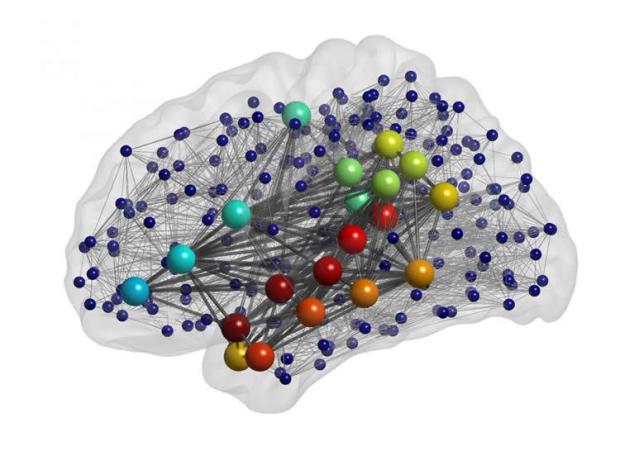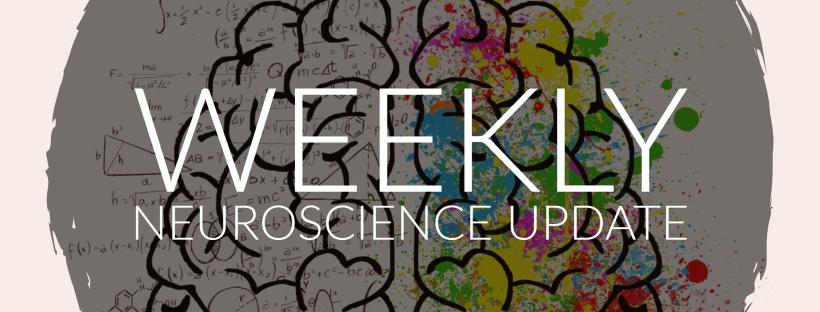Ever wonder how ballet dancers can spin and spin and spin, but never seem to get dizzy? Neuroplasticity, that’s how. This short video explains how it works, and how you can use your brain in the same way.
Category: Neuroplasticity
Weekly Neuroscience Update

Image: Bansal et al., PLOS Computational Biology, October 2018.
Scientists are using computational models of the brain to simulate how the structure of the brain may impact brain activity and, ultimately, human behavior. The research focuses on interconnectivity, looking at how different regions are linked to and interact with one another.
Using a green filter helps to increase reading speed for children with dyslexia, researchers report.
Using three different training models, researchers report mental training, mindfulness and meditation can induce structural brain plasticity and reduce social stress.
A new study reports sleep helps improve learning performance in predictable processes.
A new brain imaging study reveals how the midbrain and striatum, two key areas of the dopamine system, become more active when a person updates their beliefs about the world around them.
Researchers report deep brain stimulation has little benefit for those suffering from early onset Alzheimer’s disease.
Finally this week, a decade worth of data reveals people who multitask with different forms of media at once are worse at completing simple memory tasks.
Weekly Neuroscience Update

Chang Lab’s research reveals what area of the human brain controls the pitch of our speech.
Researchers have revealed the area of the brain that controls our voice box, allowing us to alter the pitch of our speech. The insight could pave the way for advancing neuroprosthetics to allow people who can’t speak, to express themselves in a naturalistic way.
A new study reports the brain mechanisms responsible for triggering memory are identical, whether a person is awake or asleep.
While the effects of sleep deprivation are well known, researchers discover sleeping too much could have a detrimental effect on your brain. A new study reports sleeping more than eight hours per night can reduce cognitive ability and reasoning skills.
Researchers have discovered the thalamus plays a crucial role in the development of normal sleep and waking states.
A new study reports T cells are activated in the intestines and migrate to the brain, causing an inflammatory cascade that may lead to multiple sclerosis. Researchers say the gut microbiome may play a more significant role in the development and progression of MS than previously believed.
A new study reports an afternoon nap can help us to process unconscious information and enhance cognition.
Utilizing lesion network mapping, a recently developed technique for analyzing how the brain works, researchers have studied free will perception related to movement decisions.
A new study reports a protein made by astrocytes plays a critical role in brain plasticity by assisting with neural maturation and flexibility.
Only a small proportion of cases of dementia are thought to be inherited – the cause of the vast majority is unknown. Now, in a study published today in the journal Nature Communications, a team of scientists led by researchers at the University of Cambridge believe they may have found an explanation: spontaneous errors in our DNA that arise as cells divide and reproduces.
An international team of researchers has demonstrated, with electrophysiological evidence, the existence of grid-like activity in the human brain.
Finally, this week, a new study reports people may be able to avoid depression, even if they have a genetic predisposition to SAD, by maintaining or boosting serotonin levels throughout the year.
Rewiring The Brain: Teaching An Old Dog New Tricks
For decades, scientists thought that the adult human brain was static and unchanging. But in the last few decades, we have learned that the adult brain is more dynamic than we ever imagined. In fact, the human brain is malleable and can change in response to new experiences. It is adaptable, like plastic – hence the term “neuroplasticity.”
Learn more about neuroplasticity in this infographic.

Weekly Neuroscience Update
 A new report reveals how the development of music is so closely tied to our own evolution.
A new report reveals how the development of music is so closely tied to our own evolution.
Even a single bout of physical activity can have significant positive effects on people’s mood and cognitive functions, according to a new study in Brain Plasticity.
A new study reports on the complex brain connections employed during word retrieval.
New research provides an unprecedented level of resolution and insight into disturbances in cortical GABAergic microcircuits, which are thought to underlie cognitive impairments in schizophrenia.
A sign language study helps researchers better understand how the brain processes language.
Researchers say the goal of memory is not to transmit the most accurate information over time, but to optimize intelligent decision making by holding on to valuable information.
A new study reports microglia may play a role in a diverse array of neurodegenerative and psychiatric illnesses.
A new brain imaging study shows for the first time that brain inflammation is significantly elevated – more than 30 per cent higher – in people with obsessive-compulsive disorder (OCD) than in people without the condition.
A research team has studied two structurally-similar proteins in the adult brain and have found that they play distinct roles in the development of dementia.
Neurons found to be abnormal in psychosis play an important role in our ability to distinguish between what is real and what is perceived, researchers say.
A new study sheds light on the neural mechanism behind why some people with autism are unable to make eye contact with others.
While researchers report the risk of developing psychosis from cannabis use is relatively small, those who use the drug and already suffer from schizophrenia may notice their condition worsen.
Finally this week, researchers have discovered a mechanism of glucose sensing by muscles that contribute to the regulation of blood sugar levels in the body.
Weekly Neuroscience Update
 Electrically stimulating the dorsolateral prefrontal cortex can enhance our ability to ‘think outside the box’, a new study reports.
Electrically stimulating the dorsolateral prefrontal cortex can enhance our ability to ‘think outside the box’, a new study reports.
An international team of researchers has found, for the first time, seven risk genes for insomnia. With this finding the researchers have taken an important step towards the unravelling of the biological mechanisms that cause insomnia. In addition, the finding proves that insomnia is not, as is often claimed, a purely psychological condition.
Researchers have developed a neural network based AI system that can decode and predict what a person is seeing or imagining.
A new study reports artificial intelligence used by the military to help shoot down fighter planes can accurately predict treatment outcomes for people with bipolar disorder.
New research sheds light on how the brain codes navigation behaviour at larger scales.
The visual cortex, the human brain’s vision-processing center that was previously thought to mature and stabilize in the first few years of life, actually continues to develop until sometime in the late 30s or early 40s, a neuroscientist and her colleagues have found.
Clusters of a sticky protein — amyloid plaque — found in the brain signal mental decline years before symptoms appear, a new study finds.
According to researchers, brain signals in specific brain areas change during a lifespan in ways that could be vital for maintaining flexibility.
Two new studies shed light on how the brain encodes and recalls memories.
People with voice disorders may have a problem with correctly utilizing auditory feedback to control their voices.
A new study reveals the role the motor system plays in the perception of language.
According to researchers, bilingual children perform better at voice recognition and processing than monolingual children.
Fascination with faces is nature, not nurture, suggests a new study of third-trimester fetuses.
Finally this week, the mystery of how human eyes compute the direction of moving light has been made clearer by scientists at The University of Queensland.
Weekly Neuroscience Update

People have a remarkable ability to remember and recall events from the past, even when those events didn’t hold any particular importance at the time they occurred. Now, researchers reporting in the journal Current Biology on November 23 have evidence that dogs have this kind of “episodic memory” too.
PET imaging of new neurons in the brain promises to advance our understanding and treatment of depression.
Research from Mayo Clinic included in the November issue of JAMA Neurology identifies a new biomarker for brain and spinal cord inflammation, allowing for faster diagnosis and treatment of patients.
The amount of GABA in person’s dorsolateral prefrontal cortex is linked the ability to keep several things in mind simultaneously. to new research.
A new study offers important insight into how Alzheimer’s disease begins within the brain. The researchers found a relationship between inflammation, a toxic protein and the onset of the disease. The study also identified a way that doctors can detect early signs of Alzheimer’s by looking at the back of patients’ eyes.
An international research team has found that when the brain “reads” or decodes a sentence in English or Portuguese, its neural activation patterns are the same.
In a cross-domain study, researchers have discovered unexpected cells in the protective membranes that enclose the brain, the so called meninges. These ‘neural progenitors’ – or stem cells that differentiate into different kinds of neurons – are produced during embryonic development. These findings show that the neural progenitors found in the meninges produce new neurons after birth – highlighting the importance of meningeal tissue as well as these cells’ potential in the development of new therapies for brain damage or neurodegeneration. A paper highlighting the results was published in the leading scientific journal Cell Stem Cell.
A new study reports that a single stressful event may cause long term consequences in the brain.
Researchers have identified previously unknown neural circuitry that plays a role in promoting satiety, the feeling of having had enough to eat. The discovery revises the current models for homeostatic control — the mechanisms by which the brain maintains the body’s status quo — of feeding behaviour. Published online today in Nature Neuroscience, the findings offer new insight into the regulation of hunger and satiety and could help researchers find solutions to the ongoing obesity epidemic.
Finally this week, learning by taking practice tests, a strategy known as retrieval practice, can protect memory against the negative effects of stress, according to new research.
Inside The Plastic Brain
Neuroscientist Michael Merzenich looks at one of the secrets of the brain’s incredible power: its ability to actively re-wire itself. He’s researching ways to harness the brain’s plasticity to enhance our skills and recover lost function.
Saving Brains, A Grand Challenge
Food for thought about investing in the future of our children, in this video by Dr. Mike Evans, founder of the Health Design Lab at the Li Ka Shing Knowledge Institute, an Associate Professor of Family Medicine and Public Health at the University of Toronto, and a staff physician at St. Michael’s Hospital.

